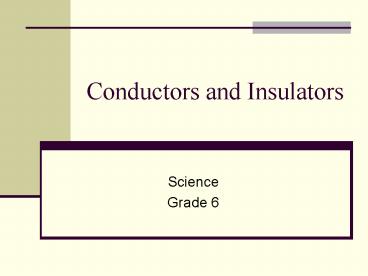Conductors and Insulators - PowerPoint PPT Presentation
1 / 17
Title:
Conductors and Insulators
Description:
Evaluate the benefits and risks that electricity presents to humans. ... too many things, cord insulation can overheat and melt, causing a shock and fire ... – PowerPoint PPT presentation
Number of Views:5464
Avg rating:3.0/5.0
Title: Conductors and Insulators
1
Conductors and Insulators
- Science
- Grade 6
2
Teacher Page
- Content Electricity
- Grade level 6
- Creator G.T. McDonald
- Curriculum objective
- Evaluate the benefits and risks that electricity
presents to humans. - Describe the characteristics of good insulators
and conductors which permit/inhibit resistance
transforming electrical energy to light and heat
energy. - Standards (G 1.2, 1.6, 1.8, 2.1, 3.8, 4.7) (SC
1, 8) (CF III.B.3, III.C)
3
Teacher Page
- Important Information
- This lesson introduces conductors and insulators
through a hands-on exploration. It also provides
an in-depth look at resistance and other factors
concerning an items ability to conduct
electricity. - Materials Needed 1 battery, wire, light bulb,
and bag of various materials per pair of
students. This bag will have things for students
to test. - Credit needs to be given to www.thetech.org for
creating a wonderful website used to help create
this presentation
4
Electrical Safety
- While electricity is very useful, it can also be
dangerous! Each year, thousands of people are
hurt or killed because they are using electricity
in an unsafe way. Remember . . . the best thing
about knowing the difference between conductors
and insulators is that they are used to make
electricity useful to us without hurting us.
5
Electrical Safety
- Electricity can be dangerous to humans and other
people. Is your home electrically safe? How about
your school? Do you know ways electricity can
hurt you if you don't use it carefully?
6
Electrical Safety
- Brainstorm individually possible electrical
dangers around your home? Write these in your
science journal. - Create a greater list by discussing with a
partner possible electrical dangers around your
home? - We will take a few minutes to create a class
graphic organizer of possible electrical hazards
at school.
7
Electrical Safety
- The following websites offer electrical safety
tips. - Rus, the Surfin' Squirrel
- In Case of Emergency!
8
Conductor or Insulator?
- First things first...Electricity can be
DANGEROUS. Don't be afraid to ask an adult for
help! - Test whether something is a conductor or
insulator - Here's what you'll need
- 1 light bulb and holder
- 1 battery and holder with 2 clips
- 2 wires
- Plastic bag with various materials to test
9
Conductor or Insulator?
- Make a prediction as to whether the item will be
a conductor or insulator. Test each item in a
simple circuit. List the materials tested under
the appropriate column in the table in your
science journal. - Evaluate the qualities that the conductors and
insulators have in common. Write this in your
journal.
10
Electricity travels throughConductors
A conductor is a material that electricity can
flow through easily.
Metals (such as copper and aluminum) are good
conductors. Thats why electrical wires are made
of metal. All the wires that lead from power
plants, to substations and transformers, and
finally into buildings have metal inside them for
electricity to travel on.
11
Electricity travels throughConductors
Water is another great conductor. Because your
body is mostly water, electricity can also travel
easily through you. (Warning if electricity
travels through you its likely you will be
seriously hurt or even killed.)
Electricity travels at the speed of light. At
186,000 miles per second, it gives you no time to
react! You cant move faster than electricity, so
you just have to stay out of its way.
12
Insulators Keep Electricity WhereIt Belongs
Electricity does not travel easily through
certain materials like special rubber, plastic,
and glass. These materials are known as
insulators and they are used to keep
electricity from leaving the wires it travels on.
13
Insulators Keep Electricity WhereIt Belongs
- Glass, plastic, or ceramic
- insulators high up on power
- poles keep electricity from
- traveling down the pole to the
- ground. If an insulator breaks, or
- a power line becomes
- disconnected from the insulators
- that hold it up, the line can fall to
- the ground and energize the
- area around it with a lot of
- electricity.
14
Insulators Keep Electricity WhereIt Belongs
- If you touch a downed
- line or even the
- ground near the line
- you could be hurt or
- killed. If a power line
- falls on a car and you
- touch the car and the
- ground at the same
- time, you would
- also get a shock.
15
Insulators Keep Electricity WhereIt Belongs
- Insulating materials also keep electricity inside
appliance cords. Rubber or plastic insulation
around the cords keeps the electricity in the
wires and prevents you from getting a shock. If
this insulation is broken or wears off, the
electricity can come through and shock you. Also,
if you overload an outlet by plugging in too many
things, cord insulation can overheat and melt,
causing a shock and fire hazard.
16
Resistance
- The following website discusses resistance and
how it affects the flow of electricity. - Tech Topics Electricity Resistance 1
17
Closure
- Create a public service announcement for
- electrical safety. This commercial should show
- possible electrical hazards and explain
- electrical safety.































